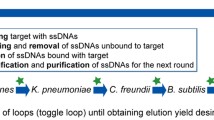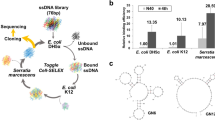Abstract
Legionella pneumophila is the major causative agent of Legionnaires’ disease and Pontiac fever, which pose major public health problems. Rapid detection of L. pneumophila is important for global control of these diseases. Aptamers, short oligonucleotides that bind to targets with high affinity and specificity, have great potential for use in pathogenic bacterium detection, diagnostics, and therapy. Here, we used a whole-cell SELEX (systematic evolution of ligands by exponential enrichment) method to isolate and characterize single-stranded DNA (ssDNA) aptamers against L. pneumophila. A total of 60 ssDNA sequences were identified after 17 rounds of selection. Other bacterial species (Escherichia coli, Bacillus subtilis, Pseudomonas syringae, Staphylococcus aureus, Legionella quateirensis, and Legionella adelaidensis) were used for counterselection to enhance the specificity of ssDNA aptamers against L. pneumophila. Four ssDNA aptamers showed strong affinity and high selectivity for L. pneumophila, with Kd values in the nanomolar range. Bioinformatic analysis of the most specific aptamers revealed predicted conserved secondary structures that might bind to L. pneumophila cell walls. In addition, the binding of these four fluorescently labeled aptamers to the surface of L. pneumophila was observed directly by fluorescence microscopy. These aptamers identified in this study could be used in the future to develop medical diagnostic tools and public environmental detection assays for L. pneumophila.




Similar content being viewed by others
Data availability
All data generated or analyzed during this study are included in this published article, and are available from the corresponding author (sunyunhaoscope@163.com) on reasonable request.
Abbreviations
- FAM:
-
6-Carboxyfluorescein
- SELEX:
-
Systematic evolution of ligands by exponential enrichment
- ELISA:
-
Enzyme linked immunosorbent assay
- CFU:
-
Colony forming units
References
Bruno JG (2015) Predicting the uncertain future of aptamer-based diagnostics and therapeutics. Molecules 20:6866–6887
Cao X, Li S, Chen L, Ding H, Xu H, Huang Y, Li J, Liu N, Cao W, Zhu Y, Shen B, Shao N (2009) Combining use of a panel of ssDNA aptamers in the detection of Staphylococcus aureus. Nucleic Acids Res 37:4621–4628
Casini B, Aquino F, Totaro M, Miccoli M, Galli I, Manfredini L, Giustarini C, Costa AL, Tuvo B, Valentini P, Privitera G, Baggiani A (2017) Application of hydrogen peroxide as an innovative method of treatment for legionella control in a hospital water network. Pathogens 6(2):556–565
Chen F, Zhou J, Luo F, Mohammed AB, Zhang XL (2007) Aptamer from whole-bacterium SELEX as new therapeutic reagent against virulent Mycobacterium tuberculosis. Biochem Biophys Res Commun 357:743–748
Cloutman-Green E, Barbosa VL, Jimenez D, Wong D, Dunn H, Needham B, Ciric L, Hartley JC (2019) Controlling Legionella pneumophila in water systems at reduced hot water temperatures with copper and silver ionization. Am J Infect Control 47(7):761–766
Dua P, Ren S, Lee SW, Kim JK, Shin HS, Jeong OC, Kim S, Lee DK (2016) Cell-SELEX based identification of an RNA aptamer for Escherichia coli and its use in various detection formats. Mol Cells 39:807–813
Duan N, Wu S, Chen X, Huang Y, Wang Z (2012) Selection and identification of a DNA aptamer targeted to Vibrio parahemolyticus. J Agric Food Chem 60:4034–4038
Duan N, Ding X, Wu S, Xia Y, Ma X, Wang Z, Chen J (2013a) In vitro selection of a DNA aptamer targeted against Shigella dysenteriae. J Microbiol Methods 94:170–174
Duan N, Wu S, Chen X, Huang Y, Xia Y, Ma X, Wang Z (2013b) Selection and characterization of aptamers against Salmonella typhimurium using whole-bacterium systemic evolution of ligands by exponential enrichment (SELEX). J Agric Food Chem 61:3229–3234
Dwivedi HP, Smiley RD, Jaykus LA (2010) Selection and characterization of DNA aptamers with binding selectivity to Campylobacter jejuni using whole-cell SELEX. Appl Microbiol Biotechnol 87:2323–2334
Dwivedi HP, Smiley RD, Jaykus LA (2013) Selection of DNA aptamers for capture and detection of Salmonella Typhimurium using a whole-cell SELEX approach in conjunction with cell sorting. Appl Microbiol Biotechnol 97:3677–3686
Gopinath SC, Tang TH, Chen Y, Citartan M, Lakshmipriya T (2014) Bacterial detection: from microscope to smartphone. Biosens Bioelectron 60:332–342
Keefe AD, Pai S, Ellington A (2010) Aptamers as therapeutics. Nat Rev Drug Discov 9:537–550
Kolovskaya OS, Savitskaya AG, Zamay TN, Reshetneva IT, Zamay GS, Erkaev EN, Wang X, Wehbe M, Salmina AB, Perianova OV, Zubkova OA, Spivak EA, Mezko VS, Glazyrin YE, Titova NM, Berezovski MV, Zamay AS (2013) Development of bacteriostatic DNA aptamers for salmonella. J Med Chem 56:1564–1572
Maita C, Matushita M, Okubo T, Matsuo J, Miyake M, Nagai H, Yamaguchi H (2016) Draft genome sequences of Legionella pneumophila JR32 and Lp01 laboratory strains domesticated in Japan. Genome Announc 4(4):1–2
Moon J, Kim G, Lee S, Park S (2013) Identification of Salmonella Typhimurium-specific DNA aptamers developed using whole-cell SELEX and FACS analysis. J Microbiol Methods 95:162–166
Park HC, Baig IA, Lee SC, Moon JY, Yoon MY (2014) Development of ssDNA aptamers for the sensitive detection of Salmonella typhimurium and Salmonella enteritidis. Appl Biochem Biotechnol 174:793–802
Peng Z, Ling M, Ning Y, Deng L (2014) Rapid fluorescent detection of Escherichia coli K88 based on DNA aptamer library as direct and specific reporter combined with immuno-magnetic separation. J Fluoresc 24:1159–1168
Rajendhran J, Gunasekaran P (2011) Microbial phylogeny and diversity: small subunit ribosomal RNA sequence analysis and beyond. Microbiol Res 166:99–110
Saad M, Chinerman D, Tabrizian M, Faucher P, S. (2020) Identification of two aptamers binding to Legionella pneumophila with high affinity and specificity. Sci Rep 10:9145
Savory N, Lednor D, Tsukakoshi K, Abe K, Yoshida W, Ferri S, Jones BV, Ikebukuro K (2013) In silico maturation of binding-specificity of DNA aptamers against Proteus mirabilis. Biotechnol Bioeng 110:2573–2580
Schmolders J, Manske C, Otto A, Hoffmann C, Steiner B, Welin A, Becher D, Hilbi H (2017) Comparative proteomics of purified pathogen vacuoles correlates intracellular replication of Legionella pneumophila with the small GTPase Ras-related protein 1 (Rap1). Mol Cell Proteomics 16:622–641
Suh SH, Jaykus LA (2013) Nucleic acid aptamers for capture and detection of Listeria spp. J Biotechnol 167:454–461
Suh SH, Dwivedi HP, Choi SJ, Jaykus LA (2014) Selection and characterization of DNA aptamers specific for Listeria species. Anal Biochem 459:39–45
Syed MA, Jamil B (2018) Aptamers and aptasensors as novel approach for microbial detection and identification: an appraisal. Curr Drug Targets 19:1560–1572
Sypabekova M, Bekmurzayeva A, Wang R, Li Y, Nogues C, Kanayeva D (2017) Selection, characterization, and application of DNA aptamers for detection of Mycobacterium tuberculosis secreted protein MPT64. Tuberculosis (edinb) 104:70–78
Tang X, Zheng J, Yan Q, Li Z, Li Y (2013) Selection of aptamers against inactive Vibrio alginolyticus and application in a qualitative detection assay. Biotechnol Lett 35:909–914
Torres-Chavolla E, Alocilja EC (2009) Aptasensors for detection of microbial and viral pathogens. Biosens Bioelectron 24:3175–3182
Wang KY, Zeng YL, Yang XY, Li WB, Lan XP (2011) Utility of aptamer-fluorescence in situ hybridization for rapid detection of Pseudomonas aeruginosa. Eur J Clin Microbiol Infect Dis 30:273–278
Woo PC, Lau SK, Teng JL, Tse H, Yuen KY (2008) Then and now: use of 16S rDNA gene sequencing for bacterial identification and discovery of novel bacteria in clinical microbiology laboratories. Clin Microbiol Infect 14:908–934
Xiong L, Zhao H, Mo Z, Shi L (2015) Prevalence of 7 virulence genes of Legionella strains isolated from environmental water sources of public facilities and sequence types diversity of L. pneumopila strains in Macau. Biosci Trends 9:214–220
Xiong L, Yan H, Shi L, Mo Z (2016) Antibiotic susceptibility of Legionella strains isolated from public water sources in Macau and Guangzhou. J Water Health 14:1041–1046
Xiong L, Yamasaki S, Chen H, Shi L, Mo Z (2017) Intracellular growth and morphological characteristics of Legionella pneumophila during invasion and proliferation in different cells. Biol Pharm Bull 40:1035–1042
Yang M, Peng Z, Ning Y, Chen Y, Zhou Q, Deng L (2013) Highly specific and cost-efficient detection of Salmonella Paratyphi A combining aptamers with single-walled carbon nanotubes. Sensors (basel) 13:6865–6881
Acknowledgements
We thank Dr. Zhenhuang Ge at Sun Yat-sen University for technical assistance in culture of L. pneumophila. We also thank Guangzhou Saite Testing Co., LTD, Guangzhou, China for technical assistance in detecting the characteristics of aptamers.
Funding
This work was supported by Funds for the Key Scientific and Technological Innovation Projects of Guangdong Forestry Bureau (Grant No. 2020KJCX009 to Yunhao Sun, for the collection of data), the National Natural Science Foundation of China (Grant No. 32000086 to Yunhao Sun, for the analysis of the data and writing of the manuscript), the Applied Basic Research Programs of Science and Technology Commission Foundation of Guangdong Province (Grant No. 2019 A1515110593 to Yunhao Sun, for the analysis of the data and writing of the manuscript), the Research Project of Innovative Institute for Plant Health from Zhongkai University of Agriculture and Engineering (Grant No. KA21031H103 to Yunhao Sun, for the collection of data), and the Starting Research Fund from Zhongkai University of Agriculture and Engineering (Grant No. KA200540844 to Yunhao Sun, for the collection of data).
Author information
Authors and Affiliations
Contributions
LX, MX and YS: conceived and designed the study. LX, QW, ZM, JZ, GY and ZD: performed the experiments. LX, YL and YS: wrote the paper. GY and ZD: reviewed and edited the manuscript. All authors read and approved the manuscript.
Corresponding author
Ethics declarations
Conflict of interest
The authors declare that they have no competing interests.
Additional information
Publisher's Note
Springer Nature remains neutral with regard to jurisdictional claims in published maps and institutional affiliations.
Rights and permissions
About this article
Cite this article
Xiong, L., Xia, M., Wang, Q. et al. DNA aptamers specific for Legionella pneumophila: systematic evolution of ligands by exponential enrichment in whole bacterial cells. Biotechnol Lett 44, 777–786 (2022). https://doi.org/10.1007/s10529-022-03252-z
Received:
Accepted:
Published:
Issue Date:
DOI: https://doi.org/10.1007/s10529-022-03252-z




